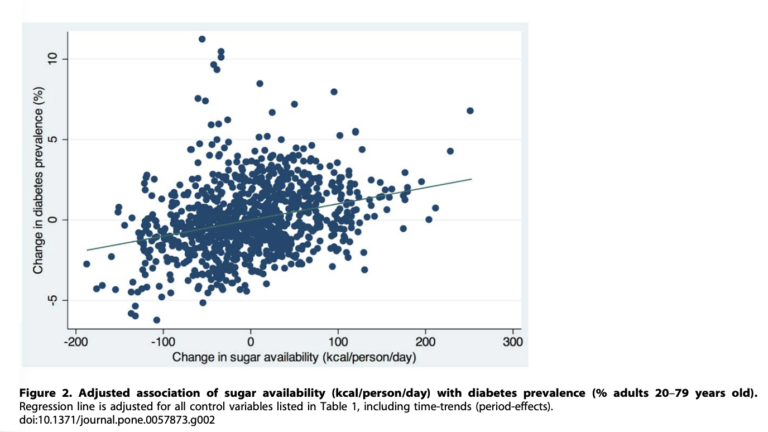This 2013 analysis, led by Robert Lustig and cited in his lecture at CrossFit HQ on March 9, 2019, investigates the association between sugar availability and diabetes.
The research team paired food supply data from the U.N. Food and Agricultural Organization (FAO) with International Diabetes Federation estimates of diabetes prevalence for 175 countries. Between 2000 and 2010, every 150-calorie increase in sugar availability was associated with a 1.1% increase in diabetes prevalence after correcting for changes in obesity, GDP, and other dietary factors. This association between sugar and diabetes explained one-quarter of the 27% increase in diabetes prevalence worldwide over this period. A similar 150-kcal/d increase in total calories consumed was not associated with diabetes prevalence, but every 1% increase in GDP associated with a 1.07% increase in diabetes. No other dietary factor was associated with a change in diabetes prevalence.
The authors acknowledge a variety of issues with this study. Like all international, observational studies, it can only show a correlation between an increase in sugar consumption and an increase in diabetes; it cannot entirely correct or account for the many other factors that have changed in these countries over time. As Figure 2 makes clear (below), some countries have shown substantial increases in diabetes prevalence over this period without an increase in sugar consumption, which suggests other important drivers may be at play. Additionally, the estimates of both sugar consumption and diabetes prevalence are imprecise—the former tracks food availability (the sum of imports and production minus exports and nonfood consumption), which does not always match consumption, while the latter is based on population surveys. These data indicate, however, that changes in sugar consumption have a stronger association with diabetes prevalence than changes in overall caloric consumption and that, at a population level, sugar consumption and GDP predict diabetes prevalence.

Figure 2